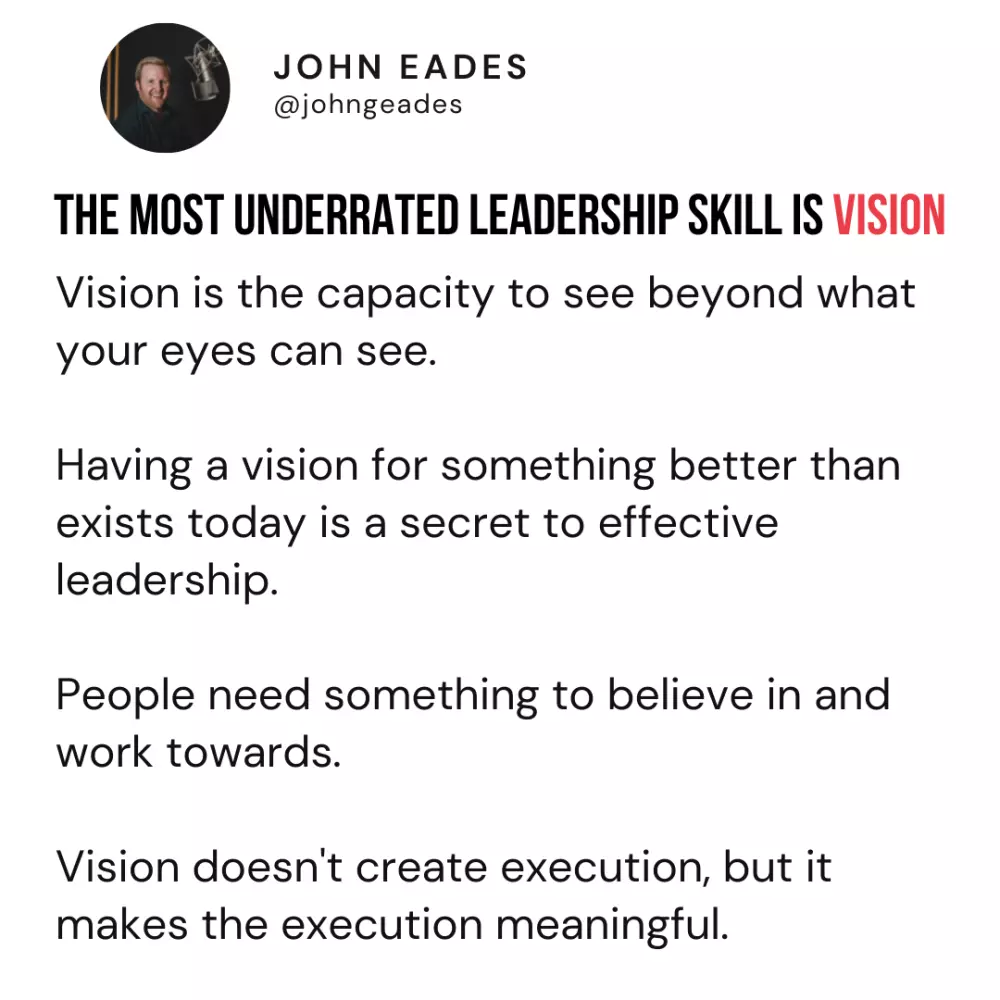Comments
- No comments found

Leadership, in many ways, is a journey of learning, refining, and applying a multitude of essential skills.
From the moment you embrace the responsibility to lead, you’re bound to this cycle whether you know it or not.
Skills like communication, coaching, accountability, and relationship building show their importance rather quickly. Then others fly under the radar like emotional intelligence, empathy, and positivity that most learn through the school of hard knocks.
As important as all these skills are to being a successful leader, there is one attribute that most people overlook and undervalue. That skill is vision.
The most underrated and often overlooked leadership skill is vision.
The reasons most leaders overlook vision as a leadership skill is typically one of three reasons:
Assume people are born as visionary
Assume its only for executive leaders like CEO’s
Have never been taught how to develop a vision
While these are common, none of these beliefs are helpful or true. However, what we have found in our research is when leaders lack vision, it limits results, reduces energy, and creates a culture that struggles to embrace change.
When leaders lack vision, it limits results, reduces energy, and creates a culture that struggles to embrace change.
In Building the Best, I defined leadership as inspiring, empowering, and serving in order to elevate others over an extended period of time. I want to emphasize “over an extended period of time.” It is extremely difficult to create an improved state for a long time without first delivering a vision of a vastly better future than exists today.
The best leaders are visionaries. They have in view what is possible in the future. They rarely know precisely how their team or organization will get there, but that’s what elite execution is for. The late great Dr. Myles Munroe used to say, “vision is the capacity to see beyond what your eyes can see.”
Vision is the capacity to see beyond what your eyes can see.
While this may sound funny, your eyes are actually the enemy of you becoming a better visionary leader. This is because they are limited to what you can physically take in.

In 1961, President John F. Kennedy was visiting NASA headquarters for the first time. While touring the facility, he introduced himself to a janitor who was mopping the floor and asked him what he did at NASA. The janitor replied, “I’m helping put a man on the moon!”
The janitor got it. He understood NASA’s vision and his part in it even though most others would say he was just mopping the floors.
In modern times, there is no better example of a visionary leader than Elon Musk, founder of Tesla and SpaceX. While astronauts have ventured into space for decades, Musk and his team at SpaceX are fervently working on space travel for the citizen population. Elon set out a beautiful and bold vision for his team, “We are going to land people on Mars by 2025.” Imagine coming to work every single day working to put human beings on Mars!
You don’t have to be the President of the United States, a janitor, or a tech titan to have a vision people can get behind. While it is true, some people may have an easier time thinking in the future tense, every single person can develop a vision and learn to see beyond what is right in front of them.
Every leader can develop their vision and learn to see beyond what is right in front of them.
Here is how I coach leaders to lean into their vision. It starts by asking these questions:
What does the future look like?
What is happening on the team or in the company?
How many people are joining you on the journey?
What kinds of people?
What is the celebration going to look like?
How are you going to feel when it happens?
How is your team going to react?
What is your family going to say?
How will the world be different?
How will the lives of the people you touch in the process be different?
Whether you have proactively thought about a vision for yourself, your team, your organization, or your family before, it's time to leverage something I learned from one of the best visionary leaders I have watched speak, Mike Whan. Whan is the CEO of the United States Golf Association (USGA) and he puts his vision into action by calling it, “Big Bold Leadership Initiatives”
Here is the exercise to come up with your own Big Bold Leadership Initiatives.
Find yourself a quiet place. Put on an inspiring playlist (here is mine on Spotify), close your eyes, and envision big, bold possibilities in the future. If you need to ask yourself the questions from above. Regardless of what comes to mind, write them down. Do this exercise at the rhythm and cadence that you require. The more often you do it, the more comfortable you will get. Of course, you always know you are becoming a visionary leader when you communicate these big bold leadership initiatives and you hear people say, “No way, that is just not possible.”
John is the CEO of LearnLoft, author of, F.M.L. Standing Out & Being a Leader and host of the 'Follow My Lead' Podcast. He writes or has been featured on Inc.com, LinkedIn Pulse, TrainingIndustry.com, eLearningIndustry.com, CNBC Money, and more. John completed his education at the University of Maryland College.
Leave your comments
Post comment as a guest